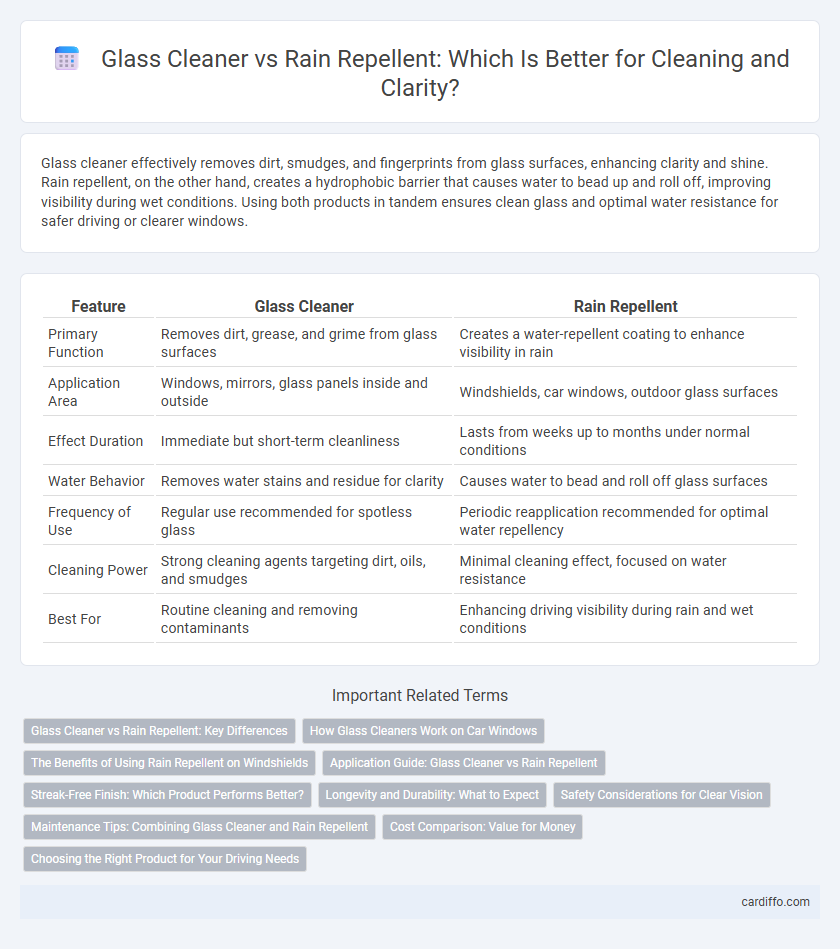Glass cleaner effectively removes dirt, smudges, and fingerprints from glass surfaces, enhancing clarity and shine. Rain repellent, on the other hand, creates a hydrophobic barrier that causes water to bead up and roll off, improving visibility during wet conditions. Using both products in tandem ensures clean glass and optimal water resistance for safer driving or clearer windows.
Table of Comparison
| Feature | Glass Cleaner | Rain Repellent |
|---|---|---|
| Primary Function | Removes dirt, grease, and grime from glass surfaces | Creates a water-repellent coating to enhance visibility in rain |
| Application Area | Windows, mirrors, glass panels inside and outside | Windshields, car windows, outdoor glass surfaces |
| Effect Duration | Immediate but short-term cleanliness | Lasts from weeks up to months under normal conditions |
| Water Behavior | Removes water stains and residue for clarity | Causes water to bead and roll off glass surfaces |
| Frequency of Use | Regular use recommended for spotless glass | Periodic reapplication recommended for optimal water repellency |
| Cleaning Power | Strong cleaning agents targeting dirt, oils, and smudges | Minimal cleaning effect, focused on water resistance |
| Best For | Routine cleaning and removing contaminants | Enhancing driving visibility during rain and wet conditions |
Glass Cleaner vs Rain Repellent: Key Differences
Glass cleaner is designed to remove dirt, grease, and smudges from glass surfaces, providing a streak-free shine and improved visibility. Rain repellent, in contrast, forms a hydrophobic coating on the glass that causes water to bead up and roll off, enhancing driving safety during rainy conditions. While glass cleaners improve clarity by cleaning, rain repellents enhance water resistance and visibility by altering the glass surface properties.
How Glass Cleaners Work on Car Windows
Glass cleaners remove dirt, grime, and oily residues from car windows through surfactants and solvents that break down and lift contaminants. These products create a streak-free finish using ingredients designed to evaporate quickly without leaving residue. Unlike rain repellents, glass cleaners focus primarily on clarity and cleanliness rather than water-beading properties.
The Benefits of Using Rain Repellent on Windshields
Rain repellent products create a hydrophobic barrier on windshields, causing water to bead up and roll off quickly, enhancing visibility during heavy rain. Unlike glass cleaners that primarily remove dirt and grime, rain repellents improve driving safety by reducing glare and minimizing the need for windshield wipers. This specialized treatment also helps prevent the buildup of water spots and reduces the adherence of bugs and debris.
Application Guide: Glass Cleaner vs Rain Repellent
For optimal windshield maintenance, apply glass cleaner using a microfiber cloth in a circular motion to remove dirt and grime before drying with a clean, lint-free towel. Use rain repellent on a dry surface, spreading it evenly with an applicator pad, and allow it to cure for the recommended time to enhance water beading and visibility during rain. Regular use of glass cleaner ensures clarity, while periodic application of rain repellent improves safety by reducing water accumulation on glass surfaces.
Streak-Free Finish: Which Product Performs Better?
Glass cleaner formulations typically contain surfactants and solvents specifically designed to break down dirt and grease, resulting in a streak-free finish on windows and mirrors. Rain repellents create a hydrophobic barrier that causes water to bead and roll off, reducing streaks caused by water spots but not necessarily removing grime effectively. For achieving a consistently streak-free appearance, glass cleaners outperform rain repellents in cleaning efficacy, while rain repellents enhance visibility by minimizing water streaks during wet conditions.
Longevity and Durability: What to Expect
Glass cleaners effectively remove dirt and grime but tend to require frequent application due to their limited durability on surfaces. Rain repellents create a hydrophobic barrier that lasts from several weeks to months, enhancing water beading and reducing the need for constant cleaning. Expect rain repellents to offer superior longevity, maintaining clearer visibility under wet conditions compared to standard glass cleaners.
Safety Considerations for Clear Vision
Glass cleaners effectively remove dirt, smudges, and streaks to enhance visibility, while rain repellents create a hydrophobic barrier that allows water to bead and roll off the surface, improving safety during wet conditions. Using a glass cleaner ensures clear vision by eliminating residues that can distort light, whereas rain repellents prevent water accumulation that obstructs the driver's line of sight. Both products contribute to safer driving but require careful application to avoid residue buildup or reduced windshield transparency.
Maintenance Tips: Combining Glass Cleaner and Rain Repellent
For optimal vehicle visibility, apply a high-quality glass cleaner to remove dirt and grime before using a rain repellent to create a hydrophobic barrier on the windshield. Regularly maintain this combination by cleaning the glass weekly and reapplying rain repellent every 1-2 months to enhance water beading and reduce streaks. This method prolongs the effectiveness of rain repellents while ensuring a clear, safe driving experience in wet conditions.
Cost Comparison: Value for Money
Glass cleaners are generally more affordable, averaging $5 to $10 per bottle, making them a budget-friendly choice for regular window maintenance. Rain repellents usually cost between $10 and $20, but their hydrophobic properties reduce the frequency of application, offering long-term savings. Evaluating cost versus durability, rain repellents provide better value for money by enhancing visibility and protection, which can reduce cleaning and maintenance expenses over time.
Choosing the Right Product for Your Driving Needs
Glass cleaner effectively removes dirt, fingerprints, and streaks from car windows, ensuring clear visibility during regular driving conditions. Rain repellent creates a hydrophobic barrier that causes water to bead and roll off the windshield, improving vision in heavy rain and reducing the need for wipers. Choosing the right product depends on climate and driving habits, with glass cleaner ideal for routine maintenance and rain repellent essential for safer driving in wet weather.
Glass cleaner vs Rain repellent Infographic

 cardiffo.com
cardiffo.com